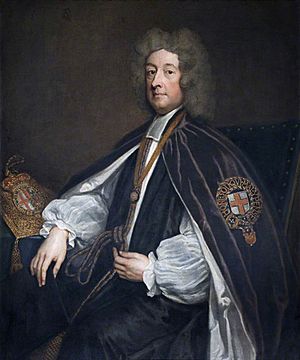William Talbot (bishop) facts for kids
Quick facts for kids The Right Reverend William Talbot |
|
|---|---|
| Bishop of Durham | |

Portrait by Godfrey Kneller, 1718
|
|
| Church | Church of England |
| Diocese | Diocese of Durham |
| Personal details | |
| Born | 1658 |
| Died | 10 October 1730 (aged 71–72) |
| Nationality | English |
| Denomination | Anglicanism |
William Talbot (born in 1658, died October 10, 1730) was an important English church leader. He served as a bishop, which is a high-ranking leader in the Church of England. He held this important role in three different places: first as the Bishop of Oxford (from 1699 to 1715), then as the Bishop of Salisbury (from 1715 to 1722), and finally as the Bishop of Durham (from 1722 to 1730).
Contents
William Talbot's Early Life and Education
William Talbot was born around 1659 at Stourton Castle in Staffordshire, England. His father was William Talbot, and his mother was Mary Stoughton.
When he was about 15 years old, in 1674, he started studying at Oriel College, Oxford. He worked hard and earned his first degree in 1677. Later, he completed his master's degree in 1680.
Becoming a Church Leader
William Talbot's first job in the church was as the rector of Burghfield, a church in Berkshire. This job was given to him by his relative, Charles Talbot, 1st Duke of Shrewsbury.
In 1691, he became the Dean of Worcester Cathedral. A dean is a senior priest who leads a cathedral. The previous dean had been removed from his position, and William Talbot was chosen to take his place.
Moving Up in the Church
In 1699, William Talbot became the Bishop of Oxford. This was a big step up in his career. He was officially made bishop on September 24 of that year.
He also received a special higher degree in theology from Oxford. This showed his deep knowledge of religious studies.
In 1710, he was involved in an important debate in the House of Lords. This was about a famous preacher named Henry Sacheverell. William Talbot was one of the bishops who spoke against Sacheverell's actions.
In 1715, he moved to become the Bishop of Salisbury. He continued to support and help other talented church leaders, including Joseph Butler and Thomas Secker.
Bishop of Durham
In 1721, William Talbot became the Bishop of Durham. This was a very important and powerful position. However, he faced some challenges there.
He tried to pass a new rule about mining leases. This rule would have given bishops more control over mining land. The plan was changed by Parliament, but he eventually worked with the local church leaders to manage things.
He also became unpopular because he increased the fees for his own land leases. He encouraged others to do the same, which upset some people. Despite his high position, he spent a lot of money and often found himself short of funds.
William Talbot passed away in London on October 10, 1730. He was buried in St James's Church, Piccadilly.
William Talbot's Writings
William Talbot wrote and published several things during his life. These included:
- Single sermons (religious speeches) that he gave between 1691 and 1717.
- His speech in the House of Lords about the Sacheverell case in 1710.
- Two "charges" (official instructions or addresses to his clergy) between 1712 and 1717.
- A letter to the clergy in Salisbury in 1716, asking them to collect money for the Moravians, a Christian group.
In 1725, he published a book called Twelve Sermons. This book shared his religious ideas, which were similar to those of another theologian named Samuel Clarke.
William Talbot's Family
William Talbot came from a notable family. He had two sisters, Frances and Catherine. His father was a descendant of Sir Gilbert Talbot, a soldier, and Elizabeth Knollys.
He was married twice. His first wife died without having children. His second wife was Catharine King. They had eight sons and several daughters.
Some of his well-known children included:
- Charles Talbot, 1st Baron Talbot (around 1685 - 1737), who became a very important lawyer and politician.
- Edward Talbot (around 1693 - 1720), who was also a church leader. His daughter, Catherine Talbot, became a writer.
- Major-General Sherrington Talbot (around 1699 - ?), a military officer.
One of his daughters, Henrietta Maria, married Charles Trimnell, who also became a bishop.

